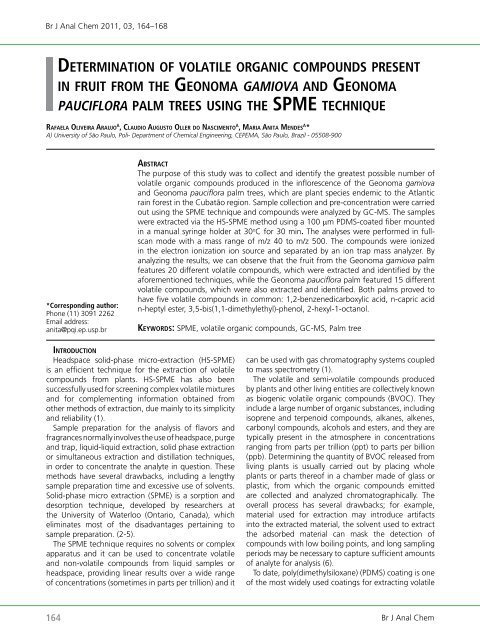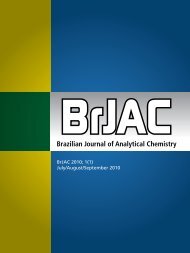Brazilian Journal of Analytical Chemistry - BRJAC - Brazilian Journal ...
Brazilian Journal of Analytical Chemistry - BRJAC - Brazilian Journal ...
Brazilian Journal of Analytical Chemistry - BRJAC - Brazilian Journal ...
You also want an ePaper? Increase the reach of your titles
YUMPU automatically turns print PDFs into web optimized ePapers that Google loves.
Br J Anal Chem 2011, 03, 164–168<br />
dE t E r m i n a t i o n o f volatilE o rg a n iC C o m P o u n d s PrEsEnt<br />
in fruit f ro m thE gE o n o m a g a m i o v a a n d gE o n o m a<br />
PauCiflora Palm trEEs u s i n g thE sPmE t E C h n i q uE<br />
ra f a E l a olivEira ara u J o a , Cl a u d i o au g u s t o ollEr d o nasCimEnto a , ma r i a an i t a mEndEs a *<br />
A) University <strong>of</strong> São Paulo, Poli- Department <strong>of</strong> Chemical Engineering, CEPEMA, São Paulo, Brazil - 05508-900<br />
*Corresponding author:<br />
Phone (11) 3091 2262<br />
Email address:<br />
anita@pqi.ep.usp.br<br />
aBstraCt<br />
The purpose <strong>of</strong> this study was to collect and identify the greatest possible number <strong>of</strong><br />
volatile organic compounds produced in the inflorescence <strong>of</strong> the Geonoma gamiova<br />
and Geonoma pauciflora palm trees, which are plant species endemic to the Atlantic<br />
rain forest in the Cubatão region. Sample collection and pre-concentration were carried<br />
out using the SPME technique and compounds were analyzed by GC-MS. The samples<br />
were extracted via the HS-SPME method using a 100 µm PDMS-coated fiber mounted<br />
in a manual syringe holder at 30 o C for 30 min. The analyses were performed in fullscan<br />
mode with a mass range <strong>of</strong> m/z 40 to m/z 500. The compounds were ionized<br />
in the electron ionization ion source and separated by an ion trap mass analyzer. By<br />
analyzing the results, we can observe that the fruit from the Geonoma gamiova palm<br />
features 20 different volatile compounds, which were extracted and identified by the<br />
aforementioned techniques, while the Geonoma pauciflora palm featured 15 different<br />
volatile compounds, which were also extracted and identified. Both palms proved to<br />
have five volatile compounds in common: 1,2-benzenedicarboxylic acid, n-capric acid<br />
n-heptyl ester, 3,5-bis(1,1-dimethylethyl)-phenol, 2-hexyl-1-octanol.<br />
kE y w o r d s : SPME, volatile organic compounds, GC-MS, Palm tree<br />
in t ro d u C t i o n<br />
Headspace solid-phase micro-extraction (HS-SPME)<br />
is an efficient technique for the extraction <strong>of</strong> volatile<br />
compounds from plants. HS-SPME has also been<br />
successfully used for screening complex volatile mixtures<br />
and for complementing information obtained from<br />
other methods <strong>of</strong> extraction, due mainly to its simplicity<br />
and reliability (1).<br />
Sample preparation for the analysis <strong>of</strong> flavors and<br />
fragrances normally involves the use <strong>of</strong> headspace, purge<br />
and trap, liquid-liquid extraction, solid phase extraction<br />
or simultaneous extraction and distillation techniques,<br />
in order to concentrate the analyte in question. These<br />
methods have several drawbacks, including a lengthy<br />
sample preparation time and excessive use <strong>of</strong> solvents.<br />
Solid-phase micro extraction (SPME) is a sorption and<br />
desorption technique, developed by researchers at<br />
the University <strong>of</strong> Waterloo (Ontario, Canada), which<br />
eliminates most <strong>of</strong> the disadvantages pertaining to<br />
sample preparation. (2-5).<br />
The SPME technique requires no solvents or complex<br />
apparatus and it can be used to concentrate volatile<br />
and non-volatile compounds from liquid samples or<br />
headspace, providing linear results over a wide range<br />
<strong>of</strong> concentrations (sometimes in parts per trillion) and it<br />
can be used with gas chromatography systems coupled<br />
to mass spectrometry (1).<br />
The volatile and semi-volatile compounds produced<br />
by plants and other living entities are collectively known<br />
as biogenic volatile organic compounds (BVOC). They<br />
include a large number <strong>of</strong> organic substances, including<br />
isoprene and terpenoid compounds, alkanes, alkenes,<br />
carbonyl compounds, alcohols and esters, and they are<br />
typically present in the atmosphere in concentrations<br />
ranging from parts per trillion (ppt) to parts per billion<br />
(ppb). Determining the quantity <strong>of</strong> BVOC released from<br />
living plants is usually carried out by placing whole<br />
plants or parts there<strong>of</strong> in a chamber made <strong>of</strong> glass or<br />
plastic, from which the organic compounds emitted<br />
are collected and analyzed chromatographically. The<br />
overall process has several drawbacks; for example,<br />
material used for extraction may introduce artifacts<br />
into the extracted material, the solvent used to extract<br />
the adsorbed material can mask the detection <strong>of</strong><br />
compounds with low boiling points, and long sampling<br />
periods may be necessary to capture sufficient amounts<br />
<strong>of</strong> analyte for analysis (6).<br />
To date, poly(dimethylsiloxane) (PDMS) coating is one<br />
<strong>of</strong> the most widely used coatings for extracting volatile<br />
164 Br J Anal Chem



